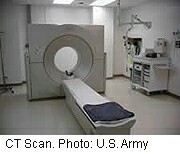
TUESDAY, Feb. 9 (HealthDay News) — The U.S. Food and Drug Administration unveiled a plan Tuesday to reduce radiation exposure from three types of increasingly widespread imaging procedures: computed tomography (CT), nuclear medicine studies and fluoroscopy.
These three imaging techniques are the largest contributors to total radiation exposure among Americans. They use much higher radiation doses than other imaging procedures — such as standard X-rays, dental X-rays and mammography — potentially increasing the lifetime risk of cancer, the agency said.
In addition to the cancer risk, accidental radiation exposure can result in injuries, such as burns, hair loss and cataracts.
“The amount of radiation Americans are exposed to from medical imaging has dramatically increased over the past 20 years,” Dr. Jeffrey Shuren, director of the FDA’s Center for Devices and Radiological Health, said in a statement. “The goal of FDA’s initiative is to support the benefits associated with medical imaging while minimizing the risks.”
While the extent of the cancer risk is a topic of debate, most experts agree that exposure to unnecessary radiation from these devices should be reduced. For example, the radiation from a CT scan of the abdomen is the equivalent of about 400 chest X-rays — and a dental X-ray has about half the radiation of chest X-ray, the FDA said.
The agency noted that the benefits of CT, nuclear medicine and fluoroscopic imaging are considerable, because they’ve led to “early diagnosis of disease, improved treatment planning and image-guided therapies that help save lives every day.”
The FDA said it’s encouraging dialogue between patients and their doctors to review the medical benefits and risks that come with these types of imaging procedures.
To help reduce unnecessary radiation exposure, the FDA is looking for the adoption of two principles. First, each procedure must be justified. Second, the dose of radiation needs to be the minimum dose required.
The agency said it hopes these measures “will promote the safe use of medical imaging devices, support informed clinical decision-making, and increase patient awareness of their own exposure.”
One expert welcomed the move.
“Studies published within the past several months have demonstrated a dramatic uptick in radiation exposure from diagnostic tests such as CT scans over recent years, with the aggregate exposure large enough to constitute a meaningful cancer risk at the population level,” said David Katz, director of the Prevention Research Center at Yale University School of Medicine. “I know from up close and personal, working in clinics, ERs and CCUs over the years, that while much of this testing is warranted, and even essential, a considerable portion is neither.”
“The actual risks of any given scan for an individual are small, and well worth taking for valuable diagnostic information,” Katz added. “But even that small risk is far too high a price to pay for a scan that is not truly necessary.”
“Standardizing criteria for exposing patients to radiation is a welcome, needed and potentially important advance,” Katz noted. “Enforcing such criteria without hindering the application of good clinical judgment will be challenging for the FDA, however. Still, establishing standards is the right first step. In medical care, the only acceptable standard is the very best we can, and we can do better than this.”
The FDA also plans to require makers of CT and fluoroscopic devices to build safeguards into their machines and to develop safer technology, and to train users of these devices on their proper use. The agency will hold a meeting in late March to get expert opinion on what needs to be done to improve the safety of these devices.
Some suggestions under consideration include requiring the devices to display and record the radiation dose being administered. The FDA said it may also require that the devices record and transmit the radiation dose used to a patient’s electronic medical record as well as to a national radiation doses database.
In a cooperative effort, the FDA and the Centers for Medicare and Medicaid Services are going to get hospitals and imaging centers to start using quality-assurance practices to improve the oversight and safe use of these imaging devices. This new program will be part of the accreditation process for these facilities, according to the FDA.
The FDA also wants professional organizations to continue to develop radiation reference levels for medical imaging procedures and to develop one or more national registries for radiation doses.
These registries would collect data from imaging facilities around the country. According to the agency, these data could help “define reference levels where they do not yet exist, validate levels that do exist, and provide benchmarks for health-care facilities to use in individual imaging studies.”
In addition, the FDA wants patients to become aware of their radiation exposure. The agency’s plan is to develop a medical imaging history card for patients to keep track of their radiation exposure.
The data would also be available on the FDA’s Web site so patients could monitor their radiation exposure and share it with their doctors. This could be particularly important for patients whose radiation exposure is not included in their medical records, the agency said.
According to the Associated Press, Tuesday’s announcement comes five months after the FDA began investigating reports of problems with CT scans at Cedars-Sinai Medical Center in Los Angeles. More than 250 patients were exposed to excess radiation, with many reporting losing hair and skin redness. The FDA has also begun investigating similar problems at two other California hospitals.
More information
For more on radiation risks from CT scans, visit the U.S. Food and Drug Administration.

